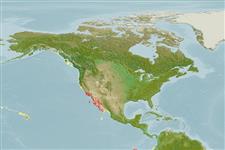Environment: milieu / climate zone / depth range / distribution range
Ecología
marino demersal; no migratorio; rango de profundidad 1 - 21 m (Ref. 2850), usually ? - 10 m (Ref. 56052). Subtropical
Eastern Central Pacific: southern California, USA to Puerto Marquez, Mexico, including the Gulf of California.
Tamaño / Peso / Age
Maturity: Lm ? range ? - ? cm
Max length : 13.0 cm TL macho / no sexado; (Ref. 2850); edad máxima reportada: 6 años (Ref. 56052)
Adults are found in rocky areas (Ref. 37955), inhabiting holes and crevices, often in burrows of boring clams or tubes of marine worms, also in mussel beds (Ref. 2850). Mostly sedentary and territorial (Ref. 2850). Demersal spawners in nearshore habitats (Ref. 56049). Oviparous. Eggs are demersal and adhesive (Ref. 205), and are attached to the substrate via a filamentous, adhesive pad or pedestal (Ref. 94114). Larvae are planktonic, often found in shallow, coastal waters (Ref. 94114).
Oviparous, distinct pairing (Ref. 205).
Eschmeyer, W.N., E.S. Herald and H. Hammann, 1983. A field guide to Pacific coast fishes of North America. Boston (MA, USA): Houghton Mifflin Company. xii+336 p. (Ref. 2850)
IUCN Red List Status (Ref. 130435)
Threat to humans
Harmless
Human uses
Herramientas
Special reports
Download XML
Fuentes de Internet
Estimates based on models
Preferred temperature (Ref.
123201): 14.9 - 24.3, mean 22.3 °C (based on 117 cells).
Phylogenetic diversity index (Ref.
82804): PD
50 = 0.5000 [Uniqueness, from 0.5 = low to 2.0 = high].
Bayesian length-weight: a=0.01000 (0.00244 - 0.04107), b=3.04 (2.81 - 3.27), in cm total length, based on all LWR estimates for this body shape (Ref.
93245).
Nivel trófico (Ref.
69278): 2.8 ±0.2 se; based on size and trophs of closest relatives
Resiliencia (Ref.
120179): Medio, población duplicada en un tiempo mínimo de 1.4-4.4 años (tmax=5.5; Fec = 1,540).
Fishing Vulnerability (Ref.
59153): Low vulnerability (10 of 100).
